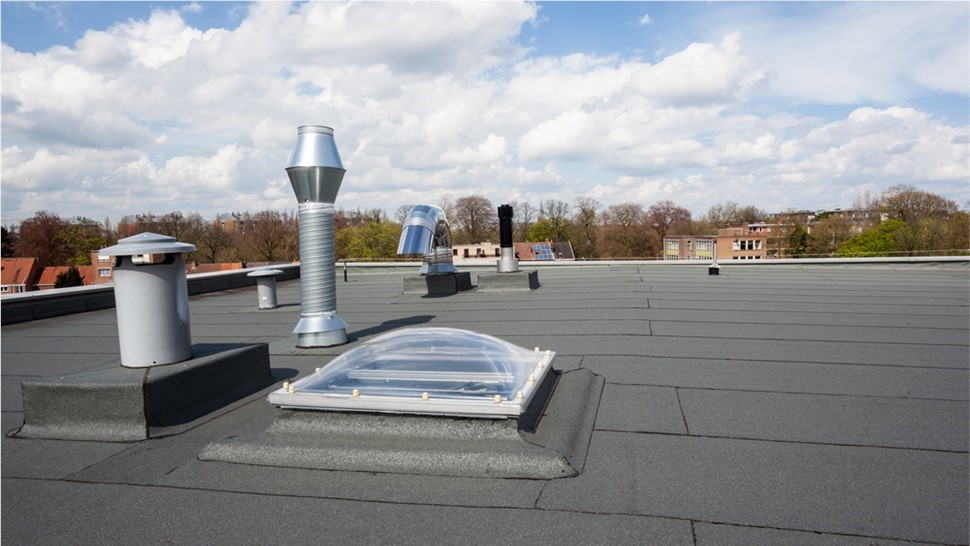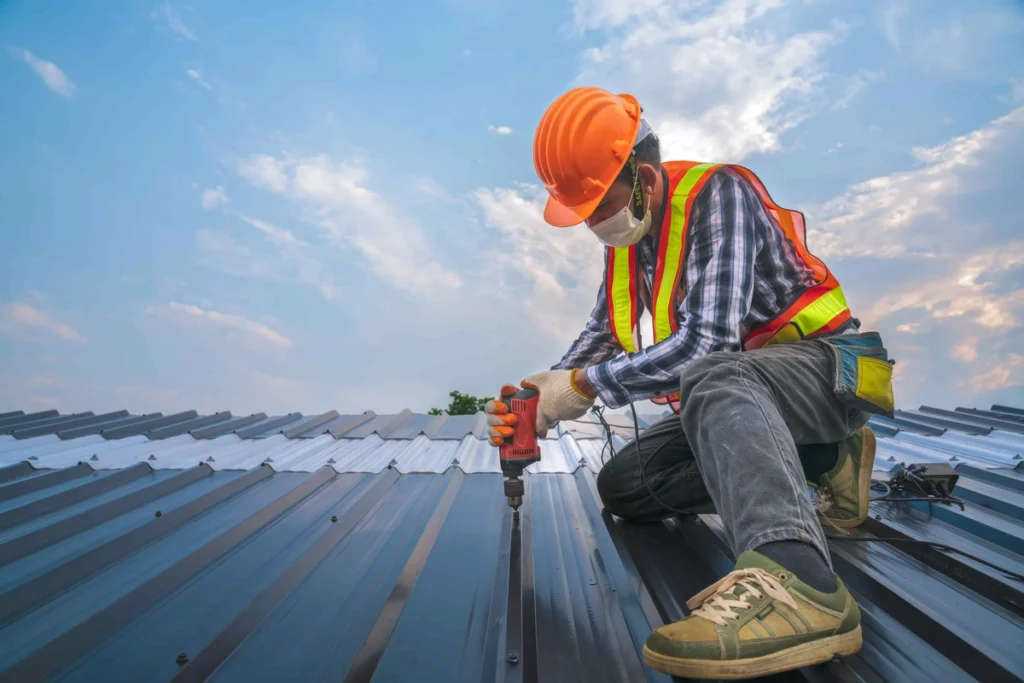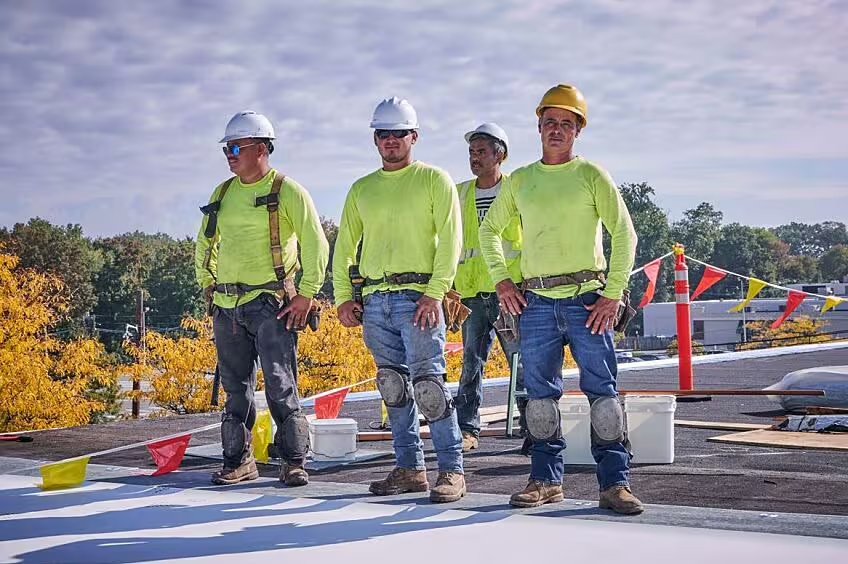Commercial roofing presents unique challenges due to its size, complexity, and specialized materials.
Unlike residential roofing, it requires expert knowledge and skill to address these complexities.
In this article, we’ll break down the difficulties of commercial roofing and help you understand what makes it more challenging than typical residential projects.
Is commercial roofing hard?
Commercial roofing can be challenging due to its larger scale and unique requirements. But with the right tools, materials, and expertise, it’s manageable for experienced contractors.
Key Takeaways
- Commercial roofing is more complex than residential roofing due to its size, materials, and specific requirements.
- It involves unique challenges, such as working with large-scale roofing systems and ensuring proper insulation and waterproofing.
- Commercial roofers need specialized training to handle the unique aspects of commercial projects.
What Makes Commercial Roofing Different?


When it comes to roofing, professional commercial buildings pose challenges that are not present with residential projects.
These buildings are typically much larger, and the roof systems can involve different materials, designs, and construction methods.
Let’s break down some of the key factors that make commercial roofing distinct from residential roofing.
1. Scale and Size
Commercial roofs are generally much larger than residential roofs. They can cover vast areas, especially for warehouses, shopping centres, and office buildings.
The sheer size of a commercial roof means that contractors need to account for larger equipment, longer working hours, and more extensive planning.
Challenge: The larger the roof, the more complicated the installation or repair process becomes.
Getting up to speed with commercial roofing requires understanding complex construction techniques.
2. Roof Design and Complexity
Commercial roofs often feature complex designs.
While residential roofs might have a straightforward gable or hip design, commercial roofs can have slopes, multiple sections, and flat areas.
They may include skylights, HVAC units, and other building infrastructure that must be accommodated during the roofing process.
Challenge: The intricacies of commercial roof designs require advanced planning and expertise.
Ensuring that every element fits together perfectly without compromising the integrity of the roof is a key challenge.
3. Material Choices
The materials used for commercial roofs can differ greatly from those used for residential projects.
While asphalt shingles are a common choice for homes, commercial roofs often use materials like metal, rubber (EPDM), or modified bitumen.
These materials have different properties and installation processes.
Challenge: Each material has its own set of installation requirements.
For instance, metal roofing needs precise installation to ensure durability, while flat roofing materials like EPDM must be carefully sealed to prevent leaks. If you’re wondering what is EPDM roofing, it’s a type of synthetic rubber membrane commonly used on low-slope buildings due to its excellent weather resistance and longevity.
The Challenges of Commercial Roofing
Now that we’ve touched on the main differences, let’s explore the specific challenges that roofing contractors face when working on commercial projects.
1. Working at Height
Like residential roofing, commercial roofing often involves working at significant heights, but the scale of commercial buildings typically means working at even greater elevations.
This can increase the risks involved in the job, especially when contractors are dealing with large, flat surfaces.
Risk Management: Safety is a critical concern. Commercial roofing contractors need to follow strict protocols to ensure their own safety while working at heights.
Proper training and use of safety gear are a must.
2. Weather Conditions
Weather can impact the progress of any roofing project.
However, on commercial projects, roofing is often done in stages, and inclement weather such as rain, high winds, or extreme temperatures can halt progress for extended periods.
Delays and Adjustments: Unpredictable weather can lead to delays, affecting the overall timeline of a commercial roofing project.
Contractors must be adaptable and prepared for any unforeseen weather-related challenges.
3. Drainage and Waterproofing
One of the most critical aspects of commercial roofing is ensuring proper drainage. A roof that does not drain properly can lead to water pooling and eventual leaks.
Waterproofing is especially important for flat roofs, which are more prone to pooling water.
Solution: Proper installation of drainage systems and the use of high-quality waterproofing materials are essential to ensure that the roof remains protected from water damage.
Contractors must ensure that these elements are incorporated into the roof design.
4. Building Codes and Regulations
Commercial roofing projects often have stricter building codes and regulations to meet.
Local laws may dictate the materials that can be used, the insulation standards, or the necessary safety features.
These requirements vary from one city or state to another, making it important for contractors to stay up-to-date with local regulations.
Challenge: Ensuring compliance with all regulations can require additional effort during planning and installation.
Contractors must thoroughly research and understand the codes that apply to the particular type of building they are working on.
Commercial Roofing Installation Process



The installation of a commercial roof is a detailed process that requires careful planning and execution. Here is a general outline of what is involved:
1. Assessment and Planning
The first step in any commercial roofing project is an assessment of the existing roof. A contractor will inspect the roof for damage, check for leaks, and evaluate its overall condition.
Based on the assessment, a detailed plan is developed to ensure the roof will meet all building codes and performance standards.
Step: Inspect and evaluate the condition of the roof and its components.
2. Roof Preparation
Before beginning the installation, the roof must be prepped.
This may involve removing the old roof, repairing the underlying structure, and ensuring that everything is in place for the new roofing material.
Step: Remove the old roofing material, fix any structural damage, and prepare the surface for installation.
3. Installation of Materials
Once the roof is prepped, the new materials are installed.
Depending on the type of roof being installed, the process may include applying membranes, adding insulation, laying down roofing sheets, or sealing joints.
Step: Lay the roofing materials, ensuring that each layer is installed correctly to guarantee durability and efficiency.
4. Inspection and Quality Control
After the roof is installed, a final inspection is conducted to ensure everything meets the agreed-upon specifications.
The roof is also tested for leaks, drainage issues, and overall performance.
Step: Perform a thorough inspection to confirm the roof is installed properly and functions as expected.
Frequently Asked Questions
1. How long does a commercial roof typically last?
A commercial roof can last anywhere from 15 to 50 years, depending on the material used, the quality of installation, and the level of maintenance it receives.
2. What type of commercial roof is best for my business?
The best roof for your business will depend on factors like climate, budget, and the type of building. Common choices include flat roofs, metal roofs, and single-ply membranes.
3. Can I repair a commercial roof myself?
While some minor repairs can be done by property owners, commercial roof repairs are best left to professionals. They have the tools and expertise to ensure repairs are done correctly and safely.
Conclusion
While commercial roofing can indeed be more complex than residential roofing, with the right team, it doesn’t have to be an overwhelming task.
The key is to choose a contractor with experience and knowledge of the specific requirements of commercial projects.
From working at great heights to managing complex designs and materials, commercial roofing demands a level of expertise that not all contractors possess.


















